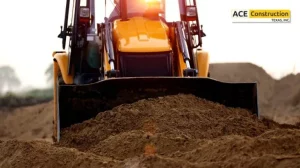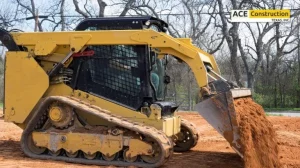Before any construction project begins, the groundwork laid during site preparation is absolutely vital. It forms the bedrock for a smooth construction process, involving critical tasks like land grading, leveling, and demolition. In this discussion, we explore the nuances of site preparation, providing valuable insights and expertise to ensure your project kicks off on the strongest possible foundation
Key Steps in Site Preparation

1. Site Evaluation and Soil Testing
Before breaking ground, conducting a thorough site evaluation is paramount. Beyond visual inspection, comprehensive soil testing determines soil stability and its bearing capacity. Understanding soil composition—whether it’s cohesive clay or gravel—directly influences foundation design and construction feasibility.
Soil Testing Methods
Testing soil is really important for building stuff like houses to make sure it’s strong and safe for the environment. Here are the main ways we do it:
- Checking the Soil: We study what kind of soil it is and how it can affect how strong a building can be.
- Testing in a Lab: We take samples of the soil and look at them in a lab to see how much weight they can handle and if they’re good for different parts of the building.
- Looking at the Environment: We also check for any bad stuff in the soil that could cause problems, so that building things follows all the rules to protect nature.”
- Surveying the Site
Employing professional surveyors to map out boundaries and topography ensures accurate project planning. This phase aids in identifying permissible construction zones and avoiding potential conflicts with existing structures or utilities.
Surveying Techniques
- Boundary Identification: Marking property lines and easements for legal compliance.
- Topographic Mapping: Creating detailed elevation maps for optimal site layout.
- Utility Mapping: Locating underground utilities to prevent damage during excavation.
- Developing the Site Design Plan
A meticulously crafted site design plan integrates survey data with project requirements. It delineates the precise placement of structures, drainage systems, and access points, laying the groundwork for efficient construction execution.
Components of Site Design Plan
- Structural Layout: Positioning buildings, roads, and infrastructure for functional efficiency.
- Drainage Design: Incorporating stormwater management and erosion control measures.
- Safety Considerations: Ensuring compliance with safety regulations and emergency protocols.
- Establishing Site Access Points
Making sure big machines and people can get in and out easily is super important. Placing entrances and exits in smart spots helps avoid traffic jams and keeps everyone safe. This makes sure work keeps going smoothly without any interruptions.
Access Point Planning
- Entry Routes: Designating primary and secondary access routes for construction vehicles.
- Safety Signage: Installing clear signage and barriers to guide traffic and ensure site security.
- Emergency Access: Providing emergency vehicle access and evacuation routes as per safety standards.
- Clearing and Demolition
Efficient removal of existing structures and debris clears the path for construction activities. Utilizing advanced equipment ensures safe and expedient site clearance, preparing the ground for subsequent construction phases.
Demolition Procedures
- Taking Down Buildings: We use safe methods to knock down structures while being careful about the environment.
- Cleaning Up: We recycle materials and get rid of waste following local rules.
- Fixing the Site: We handle any dangerous stuff or pollution to keep the site safe and green.
- Installing Drainage and Erosion Controls
Taking action early on drainage and erosion issues helps avoid problems at the construction site. Using things like retention ponds, silt fences, and erosion controls keeps the area safe and follows the best ways to manage it.
Drainage System Implementation
- Retention Ponds: Collecting and managing stormwater runoff to prevent flooding.
- Silt Fences: Containing sediment and soil particles to protect water quality.
- Erosion Control: Using vegetation and erosion blankets to stabilize soil during construction.
- Grading and Compacting
Achieving desired site contours through meticulous grading and compacting optimizes soil stability. Techniques like “cut and fill” and “split level” earthwork ensure uniform ground compaction, essential for supporting structural foundations and infrastructure stability.
Grading Techniques
- Earthmoving Equipment: Using bulldozers and graders to reshape terrain for construction purposes.
- Compaction Methods: Employing rollers and compactors to increase soil density and load-bearing capacity.
- Quality Assurance: Conducting density tests and inspections to verify compaction standards.
- Implementing a Site Safety Plan
Prioritizing safety through a site-specific safety plan mitigates on-site risks and enhances operational efficiency. Clear protocols for hazard identification, personal protective equipment (PPE) requirements, and emergency contacts foster a secure working environment.
Safety Plan Components
- Checking for Dangers: Finding out what could go wrong and fixing it before it happens.
- Teaching Safety: Teaching everyone how to stay safe at the construction site.
- Getting Ready for Emergencies: Making plans for what to do if something bad happens, like how to tell someone and where to go.
Real-life Examples and Statistical Data
- Example 1: The Millennium Tower in San Francisco, which has experienced significant tilting and settling issues, underscores the importance of comprehensive dirt work. Initial investigations pointed to inadequate soil analysis and preparation, highlighting how crucial thorough dirt work is for high-rise buildings.
- Example 2: The Leaning Tower of Pisa is a historical example of inadequate soil compaction and preparation. Modern stabilization efforts have involved extensive soil extraction and compaction techniques to prevent further tilting, demonstrating the critical role of dirt work in preserving structures.
- Statistical Data: According to a study by the American Society of Civil Engineers, over 25% of structural failures are attributed to poor soil preparation and compaction, underscoring the vital importance of practical dirt work in construction projects.
Conclusion

Effective construction site preparation is indispensable for project success, especially for site preparation contractors. By adhering to rigorous preparation protocols—from initial site evaluation to final safety measures—you establish a solid foundation for seamless construction operations. Embrace the expertise of industry leaders and leverage advanced equipment solutions to streamline your site preparation journey.
For unparalleled support in equipment rental and construction solutions tailored to your needs, connect with us today. Let’s embark on your construction journey together, ensuring every step is meticulously prepared for success.






